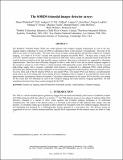The SORDS trimodal imager detector arrays
Author(s)
Wallace, Mark; McElroy, John; Harris, Bernard; Toolin, Maurice; Hynes, Michael V.; Locklin, Darren; Bray, Nick; Li, Liqian; Clifford, E. T .H.; Andrews, H. R.; Wakeford, Daniel; Lanza, Richard C; ... Show more Show less
DownloadWakeford-2009-The SORDS trimodal imager detector arrays.pdf (2.097Mb)
PUBLISHER_POLICY
Publisher Policy
Article is made available in accordance with the publisher's policy and may be subject to US copyright law. Please refer to the publisher's site for terms of use.
Terms of use
Metadata
Show full item recordAbstract
The Raytheon Trimodal Imager (TMI) uses coded aperture and Compton imaging technologies as well as the nonimaging shadow technology to locate an SNM or radiological threat in the presence of background. The heart of the TMI is two arrays of NaI crystals. The front array serves as both a coded aperture and the first scatterer for Compton imaging. It is made of 35 5x5x2" crystals with specially designed low profile PMTs. The back array is made of 30 2.5x3x24" position-sensitive crystals which are read out at both ends. These crystals are specially treated to provide the required position resolution at the best possible energy resolution. Both arrays of detectors are supported by aluminum superstructures. These have been efficiently designed to allow a wide field of view and to provide adequate support to the crystals to permit use of the TMI as a vehicle-mounted, field-deployable system. Each PMT has a locally mounted high-voltage supply that is remotely controlled. Each detector is connected to a dedicated FPGA which performs automated gain alignment and energy calibration, event timing and diagnostic health checking. Data are streamed, eventby- event, from each of the 65 detector FPGAs to one master FPGA. The master FPGA acts both as a synchronization clock, and as an event sorting unit. Event sorting involves stamping events as singles or as coincidences, based on the approximately instantaneous detector hit pattern. Coincidence determination by the master FPGA provides a pre-sorting for the events that will ultimately be used in the Compton imaging and coded aperture imaging algorithms. All data acquisition electronics have been custom designed for the TMI.
Date issued
2009-04Department
Massachusetts Institute of Technology. Department of Nuclear Science and EngineeringJournal
Proceedings of SPIE
Publisher
The International Society for Optical Engineering
Citation
Wakeford, Daniel et al. “The SORDS trimodal imager detector arrays.” Non-Intrusive Inspection Technologies II. Ed. Brandon W. Blackburn. Orlando, FL, USA: SPIE, 2009. 73100D-9. © 2009 SPIE--The International Society for Optical Engineering
Version: Final published version
ISSN
0277-786X